Trine 2 – Review
by Chris
|
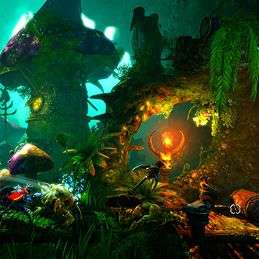 Remember that time when you were still really young and you were given a video game? A brand spanking new one, all shiny in its wrapper, full of promise, joy and utter brilliance? Nothing could dissuade that feeling that you’d achieved total Nirvana (no, not Kurt Cobain… Google it, kids) just by playing a video game. You may have been young and naive, but you already knew that games were supposed to be fun. Fast forward twenty-five years and by Christ, have we had a wake up call. The world is an evil place; totally and utterly crammed full of bastard coated bastards with a hard-bastard centre. You work long hours, put up with more shit than a sewage worker, and have to pretty much take whatever’s flung in your direction without question. Not only that, but your one refuge, your one bastion of solitude – the humble video game – has been bastardised to the point where every Tom, Dick and Harry is waving a white oblong penis around, making your favourite plumber jump through hoops and calling it entertainment.
Remember that time when you were still really young and you were given a video game? A brand spanking new one, all shiny in its wrapper, full of promise, joy and utter brilliance? Nothing could dissuade that feeling that you’d achieved total Nirvana (no, not Kurt Cobain… Google it, kids) just by playing a video game. You may have been young and naive, but you already knew that games were supposed to be fun. Fast forward twenty-five years and by Christ, have we had a wake up call. The world is an evil place; totally and utterly crammed full of bastard coated bastards with a hard-bastard centre. You work long hours, put up with more shit than a sewage worker, and have to pretty much take whatever’s flung in your direction without question. Not only that, but your one refuge, your one bastion of solitude – the humble video game – has been bastardised to the point where every Tom, Dick and Harry is waving a white oblong penis around, making your favourite plumber jump through hoops and calling it entertainment.
To say that I’ve become cynical and devoid of all hope at the ripe old age of twenty-five is something of an understatement. Great games are rarer to come by these days. I’m not talking about good games; there are plenty of those. I’m talking about those emotion-invoking ones that take you back to being a child, and remind you just how much fun you can have with a video game. Trine 2 is one of those games.
Trine 2 allows the player to reprise the multiple personalities of Amadeus, Pontius and Zoya as they move from left to right, fighting monsters and solving puzzles. For people slow on the uptake, the ‘left to right’ comment indicates that this is a side-scroller and should feel immediately familiar to anyone who played the prequel Trine. I personally didn’t, but knew enough about it to recognise it instantly.
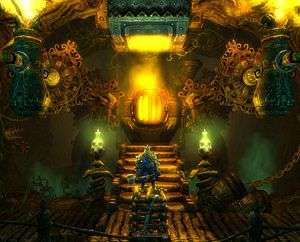 One of the most important parts of this game is its characters. The three heroes of this particular piece are back, living their separate lives prior to The Trine (a mystical artefact) showing up and whisking them away. For newcomers to the series, you’re given a brief time to handle each character individually before their destinies are intertwined into one changeable being.
One of the most important parts of this game is its characters. The three heroes of this particular piece are back, living their separate lives prior to The Trine (a mystical artefact) showing up and whisking them away. For newcomers to the series, you’re given a brief time to handle each character individually before their destinies are intertwined into one changeable being.
First you have Amadeus, the wizard; he is something of a coward but speaks more common sense than the other two and can regularly be heard moaning about having to go on the adventure in the first place, apparently being more concerned about what his wife’s going to do to him when he gets back. Priorities and all that, I suppose.
Generally I found him to be the weakest of the characters, although this does obviously depend on your point of view. From a puzzle-solving perspective he’s invaluable. By using the mouse you can draw a box and alas one will appear. To begin with, that is quite literally all he can do. This means that, in a combat situation, he’s about as useful as a chocolate shield in a volcanic storm as he has no tactical choice but to run away. Although his conjured boxes appear to be made out of metal clockwork parts, they’ve got less structural integrity than a house of cards and most enemies just smash straight through them. Not great for combat, but will solve the majority of your puzzle-related roadblocks.
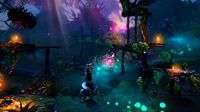 |
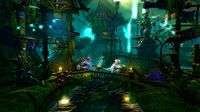 |
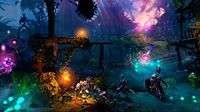 |
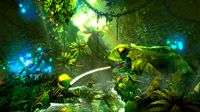 |
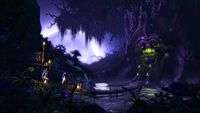 |
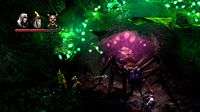 |
Next you have Pontius, the knight. He fits the usual bill of being a gallant hero of the kingdom, although he looks like he’s seen a few too many celebratory feasts and not enough dragon slaying, but who am I to judge? He’s the one with the big fucking sword. Yes, Pontius is goblin-smashing, spider-crushing, general-level-wrecking man of action. He comes equipped with the aforementioned sword and a shield to boot. The shield will protect him from the majority of the game’s hazards, (it’s acid proof according to our hero, and he’s not lying) and it makes for a handy swimming aid (you’ve really got to see it to believe it). While Pontius is more than ready to get his hands dirty when it comes to a fight, he’s not got many uses puzzle-wise, although he can smash a few obstacles if need be but even if he does, you’ll probably need one of the other people to make use out of whatever it reveals.
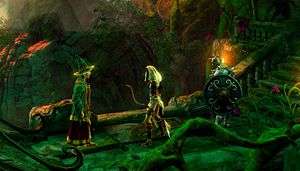 Finally you have Zoya, the thief. She’s a very pleasant blend of both combat and puzzle-solving, with an eye for treasure, but also has a certain amount of intrigue about her. She doesn’t shy away from danger, but is also focussed in looking out for herself. I’ve found myself using her more often than the other characters and, being a thief, she’s all about stealth and deception. I’m not into any of that bollocks though, so while I’m pulling the strings, she’s flying all over the place using her grappling hook and firing arrows at anyone that Pontius hasn’t already gutted.
Finally you have Zoya, the thief. She’s a very pleasant blend of both combat and puzzle-solving, with an eye for treasure, but also has a certain amount of intrigue about her. She doesn’t shy away from danger, but is also focussed in looking out for herself. I’ve found myself using her more often than the other characters and, being a thief, she’s all about stealth and deception. I’m not into any of that bollocks though, so while I’m pulling the strings, she’s flying all over the place using her grappling hook and firing arrows at anyone that Pontius hasn’t already gutted.
The story itself is fairly forgettable, which is a shame given the colourful and interesting characters you’re given to work with. Thankfully, however, it does pick up somewhat in latter parts of the game. While I continued playing regardless, other players who look for a story to motivate them, to propel the game forwards, may be disappointed. Suffice it to say, there is a strange kingdom, some giant talking plants and a princess. There is also an air of mystery to the story but that only gets revealed, as I said, much later on. I do, however, think that it could have been incorporated sooner to help with pacing.
Narrated in a fairy tale style, the story is told by a male with a nonchalant manner. He certainly doesn’t sound bad but equally doesn’t sound all that interested, although he does try. I just can’t escape the feeling that he’s not invested in the story, and his voice very quickly becomes nothing more than a drone. It probably wouldn’t have been a problem a decade ago, but I’ve been spoiled by the likes of Patrick Stewart and Logan Cunningham and it’s for that reason that I really didn’t enjoy the narration in Trine 2, and wanted to skip through it at every opportunity.
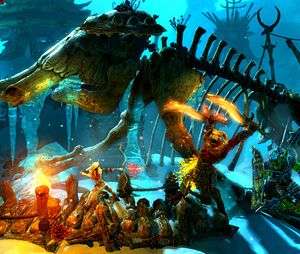 Nevertheless, I’m not here to have some man tell me a story. I’m here to get knee-deep in some puzzles and bad guy guts. Thankfully, where the story is lacking, Trine 2 makes up for it with its gameplay and I’m told that it’s similar to the first, so if you enjoyed that and wanted more, you’ve come to the right place. The puzzles themselves start off insultingly easy, and I scoffed as Amadeus magicked up a box to jump between ledges or Zoya swung across pits. What stops you rushing through these early stages is the orbs. In every part of every level, there are tons of these blue orbs. Some are floating, quite innocently, in mid-air while others are trapped behind barricades, ready to tumble out and some are left totally out of view. You collect these orbs as you progress, and for every fifty points you can level up one of your heroes’ abilities.
Nevertheless, I’m not here to have some man tell me a story. I’m here to get knee-deep in some puzzles and bad guy guts. Thankfully, where the story is lacking, Trine 2 makes up for it with its gameplay and I’m told that it’s similar to the first, so if you enjoyed that and wanted more, you’ve come to the right place. The puzzles themselves start off insultingly easy, and I scoffed as Amadeus magicked up a box to jump between ledges or Zoya swung across pits. What stops you rushing through these early stages is the orbs. In every part of every level, there are tons of these blue orbs. Some are floating, quite innocently, in mid-air while others are trapped behind barricades, ready to tumble out and some are left totally out of view. You collect these orbs as you progress, and for every fifty points you can level up one of your heroes’ abilities.
It’s an excellent way of keeping things fresh in the opening stages. You could quite easily rush straight through, or opt to try and hunt down everyone of these buggers. I’m not an achievement whore, nor do I care about collectables and yet, for some reason, I wanted all of those orbs. They do come in handy, because some of the abilities you can unlock are actually pretty enjoyable. Amadeus really just becomes more of a puzzle cracker, introducing abilities to create more boxes and a ‘plank’. Zoya picks up various flavours of arrows and a stealth move, while Pontius gets to deal more damage and a very important hammer that you can… throw at things. Very cool. Some of the later unlockables require you to save up the skill points, so it does become a question of what to invest in and when, adding some depth to the game, but also causing problems.
 |
 |
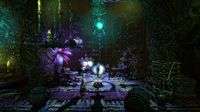 |
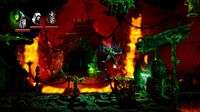 |
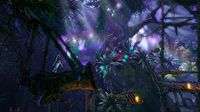 |
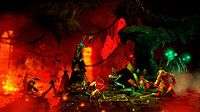 |
For example, if I were to ignore Zoya and Pontius and just plug all the skill points in to Amadeus, I’d be creating four boxes and planks fairly early on. This would make some of the mid-level puzzles incredibly easy. I obviously can’t confirm my next statement, but I’m pretty certain that I managed to cheat at some puzzles by jumping from a ledge to a plank and a box that I managed to conjure in mid-air. No idea if that’s right or not, but surely that can’t be the solution. If you hadn’t taken the skill points down that path you wouldn’t know to do it. It’s a bizarre moment when you do encounter this and you wonder if you’ve trumped the game by accident.
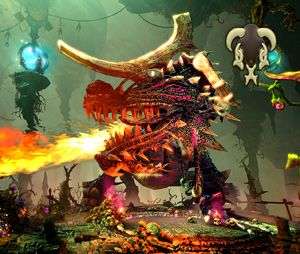 Not all puzzles can be broken (if at all) this way and the ones that don’t are very well created. The Portal series is easily one of the cornerstones of physics-based puzzle games and while the Trine series may not be as well-considered, they certainly can tease a braincell or two. Many of the puzzles revolve around water or air currents, and they’ve even thrown in a cheeky portal or two to boot. None of these should have you stumped for days, ripping your hair out and beating the screen to death with the keyboard, but they will make you stop to take a look at the situation and wonder what needs to be done. No puzzle takes longer than perhaps ten minutes, which isn’t necessarily a bad thing and is actually quite refreshing. Frozenbyte should certainly be commended for making the puzzles challenging, yet not frustrating.
Not all puzzles can be broken (if at all) this way and the ones that don’t are very well created. The Portal series is easily one of the cornerstones of physics-based puzzle games and while the Trine series may not be as well-considered, they certainly can tease a braincell or two. Many of the puzzles revolve around water or air currents, and they’ve even thrown in a cheeky portal or two to boot. None of these should have you stumped for days, ripping your hair out and beating the screen to death with the keyboard, but they will make you stop to take a look at the situation and wonder what needs to be done. No puzzle takes longer than perhaps ten minutes, which isn’t necessarily a bad thing and is actually quite refreshing. Frozenbyte should certainly be commended for making the puzzles challenging, yet not frustrating.
If puzzles aren’t your thing, then your probably more of a combat person. Orcs, spiders and vicious plants are among some of the creatures that will try to stop your progress in Trine 2. Combat is generously sprinkled between various puzzles and if your fighting against the Orcs, you’ll find a mix of offensive and defensive enemies – smaller guys with knives, bigger guys with clubs, and archers all vie to exterminate the player. Surviving these encounters usually requires a blend of both Pontius and Zoya, and I was pleased to discover that it’s not all just down to Pontius to fight the opposition, as it’d feel generic and arbitrary. “Here’s the big guy, he’s for fighting!” Instead, Zoya assists with ranged opposition thanks to her bow. Amadeus, on the other hand, is only good for slipping over in Orc guts and cracking his skull on one of his magically-created boxes.
While the combat is fun, it does get a little stale towards the end. Sheer numbers make way for challenge and it’s a case of being overwhelmed rather than your own lack of skill. Pontius can only point his shield in one direction, and the other two can’t block attacks at all. There isn’t much variety in opposition either, although this is a very small bone of contention; you’re out to fight the Goblin King after all, so having some robots and the Russian Spetsnaz show up to add something different would be a little out of place. Magical powers and Russian Spetsnaz? Now that’s a game I’d like to see. Some of the better character-killers are the ones you can’t actually kill. These take the form of man-eating plants and giant spiders. There’s no killing those bastards, and it’s an excellent blend of puzzling and scare tactics that force you to circumvent rather than fight your way past the opposition.
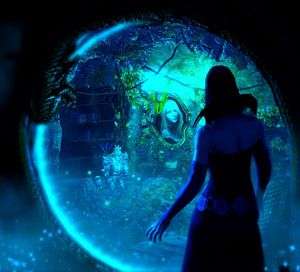 When I first saw Trine 2, what drew me to it, having very little knowledge of the series, were the graphics. The still images you see are gorgeous and portray a vibrant, colourful world; it looks to be full of life, imagination, and magic. It screams creativity. In motion, it does all of that but with the awesome cranked all the way up to maximum. In short, this is quite possibly the most gorgeous looking game I’ve ever seen. Your Battlefields and Calls Of Duty may be able to mimic realism until the in-game models leap out of the screen, slap them in the face and say “STOP CASHING IN ON THE SAME SHIT EVERY FUCKING YEAR” but what they don’t have is a world dripping with substance, style and, most importantly, belief. It’s a strange thing to say; that a world modelled on our own seems like more of a game than the lush environments I’ve been bounding around in Trine 2.
When I first saw Trine 2, what drew me to it, having very little knowledge of the series, were the graphics. The still images you see are gorgeous and portray a vibrant, colourful world; it looks to be full of life, imagination, and magic. It screams creativity. In motion, it does all of that but with the awesome cranked all the way up to maximum. In short, this is quite possibly the most gorgeous looking game I’ve ever seen. Your Battlefields and Calls Of Duty may be able to mimic realism until the in-game models leap out of the screen, slap them in the face and say “STOP CASHING IN ON THE SAME SHIT EVERY FUCKING YEAR” but what they don’t have is a world dripping with substance, style and, most importantly, belief. It’s a strange thing to say; that a world modelled on our own seems like more of a game than the lush environments I’ve been bounding around in Trine 2.
I’m no graphical genius; I can’t tell you about pixels, sprites or any of that jargon. I’ve got no idea what makes Trine 2 look so gorgeous and, from a consumer point of view, I don’t need to. The game looks awesome but, at the same time, it’s so much more than that. Trine 2 is teeming with life. It oozes and drips from every pore of the game. The landscapes you move through react to your every touch. Leaves flap in the wind, boxes bounce their way down bottomless canyons and our heroes slip and slide through a world that even they seem amazed by. It only adds another layer of immersion that the people you’re guiding through this world don’t just treat it as yet another location that they’ve probably all seen before. They appear to be as genuinely amazed as I was. I don’t usually point out specific things from a game that I loved in a review, but the level that seemed based around a witches lair or witches den was simply incredible. Everything that was going on in the foreground, the background, above me, below me… all merged into this one believable world that totally engrossed me. Graphics is easily Trine 2′s trump card over a good majority of the games currently on the market and if what your eyes see is the trump card, then what your ears hear is the ace up the sleeve. Trine’s whimsical score will have you tapping and bobbing your head along as you play; some can get a little repetitive but, for the most part, they are excellent and change by level, doing a stellar job of further expressing the world around you. Each character speaks at various points in each level, and it is fun to hear them squabble amongst themselves or voice an opinion. Genius.
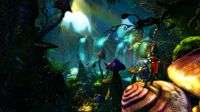 |
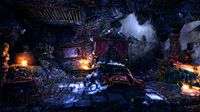 |
 |
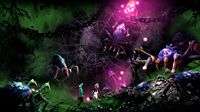 |
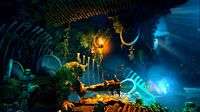 |
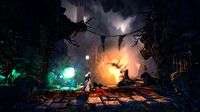 |
Having played through Trine 2, I didn’t explore the co-op side of things. I am reliably informed that it is a giggle though. You can essentially spawn multiple types of each character which problem makes the game a little easier but ultimately more fun. It will certainly take some of the pressure off the later puzzles which had no problem in being a real tough nut to crack.
Pros- Quite frankly, the most beautiful graphics I've seen in a video game
- Fun puzzles that keep you guessing
- Easy to pick up and play
- Enjoyable characters that are refreshing and well designed
- Very basic plot
- Does take a while to get going in all areas
- Not much in the way of replay value
Trine 2 is certainly a good game. I can certainly recommend it if you're tired of playing the same old stuff, because it is a very quirky and unique title. Graphically, it is one of a kind and I can easily endorse it on that basis alone. It's by no means perfect, and its faults did cause frustration at points, simply because this is an excellent game that just falls short of utter awesome. If you've not played the first, then I fully recommend that you pick this up. If you have played the first and liked it, then you'll almost certainly enjoy Trine 2. If you didn't like the first, hate puzzle games, and don't like gorgeous graphics then get back to your boring, colourless life, caveman!
Last five articles by Chris















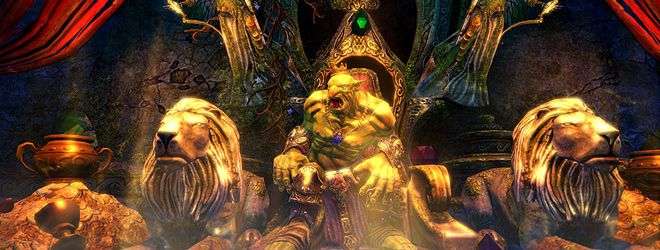
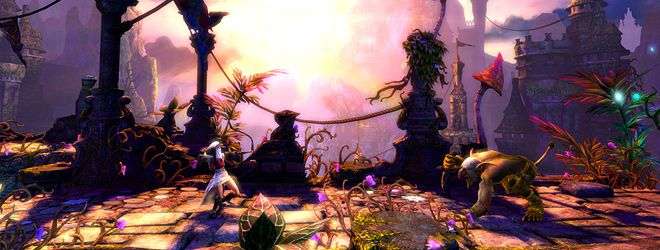







[...] title and certainly worth your time. I would go on about it but I’ve written a full review here. So feel free to check it [...]
Sounds like you had a lot of fun with it, and it’s so pretty that it’s caught my eye something fierce.
Good job Chris